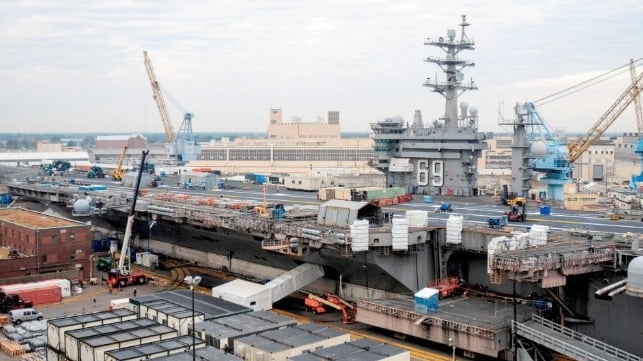Opinion: U.S. Navy's Shipyards Need a Boost From Congress

America is home to some of the finest shipbuilders in the world. This industry is becoming increasingly vital to our national security as we seek to build a larger Navy capable of confronting China. Unfortunately, our shipyards are aging and are too small to expand our fleet at the pace that is needed. As lawmakers consider what to include in an upcoming infrastructure bill, I am leading a bipartisan effort to provide a significant boost to infrastructure at our nation’s shipyards.
My proposal, known as the SHIPYARD Act, would provide $25 billion to improve shipyards, including $21 billion for the Navy’s four public yards and another $4 billion for private construction and repair yards like Ingalls Shipbuilding and VT Halter in Mississippi. I am encouraged by the growing bipartisan support for the SHIPYARD Act and hope it will be included as part of an infrastructure package.
Shipyards Need Bigger, More Modern Facilities
In 2017, Congress passed the SHIPS Act, legislation I authored making it the policy of the United States to build a 355-ship Navy as soon as practicable. This was an important step, but Congress now needs to clear away obstacles to reaching this goal. Our shipyards in their current state are struggling to service our existing fleet of 296 ships, let alone the massive fleet we need to compete with our adversaries.
The Navy owns and operates four shipyards, which are responsible for maintaining our aircraft carriers and submarines. All four of these facilities are more than 100 years old and in desperate need of upgrades. Aging equipment and a shortage of usable repair docks have caused long maintenance delays, resulting in fewer ships being ready for deployment. This slow process has kept us from building our fleet in a timely manner and allowed China to begin challenging American supremacy at sea.
China’s Shipyards Enable Beijing to Project Power
China has become our primary strategic rival and will likely remain so for the foreseeable future. Although our military enjoys technological advantages, China’s Navy has eclipsed ours in terms of sheer size, surpassing 350 ships. China has achieved this massive naval force by dramatically expanding its shipbuilding and maintenance base, with more than 1,000 shipyards now supporting its sprawling fleet. The United States has significant ground to make up.
The Navy has been doing the best it can with the resources at its disposal. In 2018, the Navy released a 20-year plan for revitalizing its shipyards. But 20 years is far too long to meet our pressing security needs.
The SHIPYARD Act would help speed up the Navy’s plan by funding it all at once, with appropriations that would not expire at the end of any fiscal year. This would give the Navy flexibility to ramp up operations on the most efficient timeline possible. The Navy would be able to put these funds toward projects at a range of facilities, including major shipyards and the many contractors and suppliers that help build U.S. Navy ships.
Shipyards are not our military’s only infrastructure need, but they are the source of our nation’s sea power and are playing an increasingly pivotal role in the global balance of power. As Congress considers what infrastructure priorities will best serve our communities and advance our national security, our nation’s shipyards must be a priority.
Sen. Roger F. Wicker has represented Mississippi in the United States Senate since December 2007. He is the ranking member of the Senate Committee on Commerce, Science, and Transportation for the 117th Congress.
The opinions expressed herein are the author's and not necessarily those of The Maritime Executive.
